The goal of NetworkExtinction is to Simulate the extinction of species in the food web and to analyze its cascading effects, as described in Dunne et al. (2002)
You can install the released version of NetworkExtinction from CRAN with:
install.packages("NetworkExtinction")And the development version from GitHub with:
# install.packages("devtools")
devtools::install_github("derek-corcoran-barrios/NetworkExtinction")The Mostconnected() function sorts the species from the
most connected node to the least connected node, using total degree.
Then, it removes the most connected node in the network, simulating its
extinction, and recalculates the topological indexes of the network and
counts how many species have indegree 0 (secondary extinction), not
considering primary producers. Then, it removes the nodes that were
secondarily extinct in the previous step and recalculates which node is
the new most connected species. This step is repeated until the number
of links in the network is zero (Sole and Montoya 2001; Dunne, Williams,
and Martinez 2002; Dunne and Williams 2009).
library(NetworkExtinction)
data("net")
SimulateExtinctions(Network = net, Method = "Mostconnected")The result of this function is a list which contains the dataframe
shown in table 1. The first column called Spp indicates the
order in which the species were removed simulating an extinction. The
column Secondary_extinctions represents the numbers of species
that become extinct given that they do not have any food items left in
the food web, while the AccSecondaryExtinction column
represents the accumulated secondary extinctions. (To plot the results,
see function ExtinctionPlot().)
data("More_Connected")
history <- SimulateExtinctions(Network = net, Method = "Mostconnected")
ExtinctionPlot(History = history[[1]], Variable = "AccSecExt")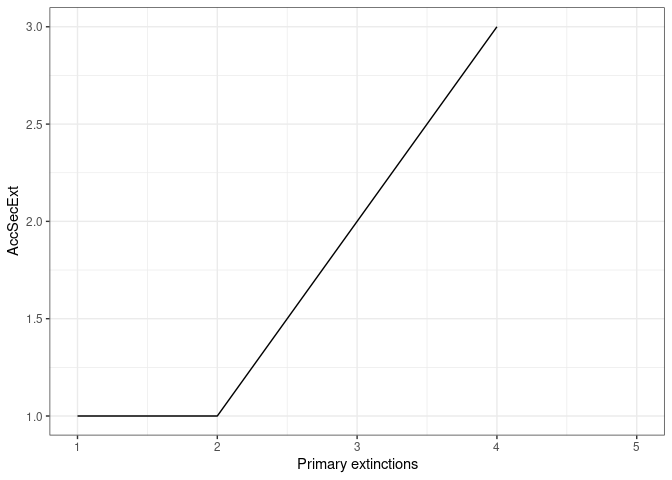
Figure 3. The graph shows the number of accumulated secondary extinctions that occur when removing species from the most to the least connected species
In addition, the list returned by SimulateExtinctions()
also contains the final Network that remains after all primary
extinctions have been finished:
The ExtinctionOrder() function takes a network and
extinguishes nodes using a customized order. Then, it calculates the
topological network indexes and the secondary extinctions. In our toy
network, nodes 1-4 are primary producers while nodes 9 and 10 represent
apex predators. Let’s see what happens when we sequentially remove all
but the apex predators:
data("net")
SimulateExtinctions(Network = net, Order = 1:8, Method = "Ordered")Already at the removal of node 5, we loose support for all other species in the network.
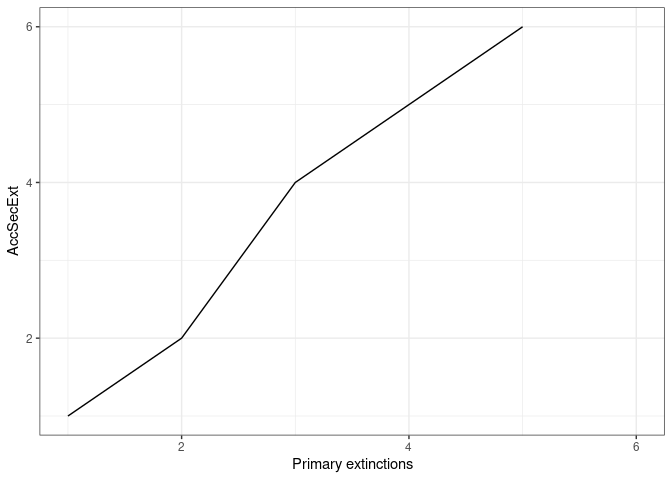
Figure 4. The graph shows the number of accumulated secondary extinctions that occur when removing species in a custom order.
The results of this function are a dataframe with the topological indexes of the network calculated from each extinction step (Table 2), and a plot that shows the number of accumulated secondary extinctions that occurred with each removed node (Figure 4).
The RandomExtinctions() function generates n random
extinction orders, determined by the argument nsim. The
first result of this function is a dataframe (table 3). With the
SimNum argument, you can control how many of the nodes in
the network should be simulated to go extinct for each random extinction
order. Here, we choose the same number as we set for our custom order
example above.
The column NumExt represents the number of species removed, AccSecondaryExtinction is the average number of secondary extinctions for each species removed, and SdAccSecondaryExtinction is its standard deviation. The second result is a graph (figure 5), where the x axis is the number of species removed and the y axis is the number of accumulated secondary extinctions. The solid line is the average number of secondary extinctions for every simulated primary extinction, and the red area represents the mean \(\pm\) the standard deviation of the simulations.
data(net)
set.seed(707)
RandomExtinctions(Network= net, nsim= 100, SimNum = 8)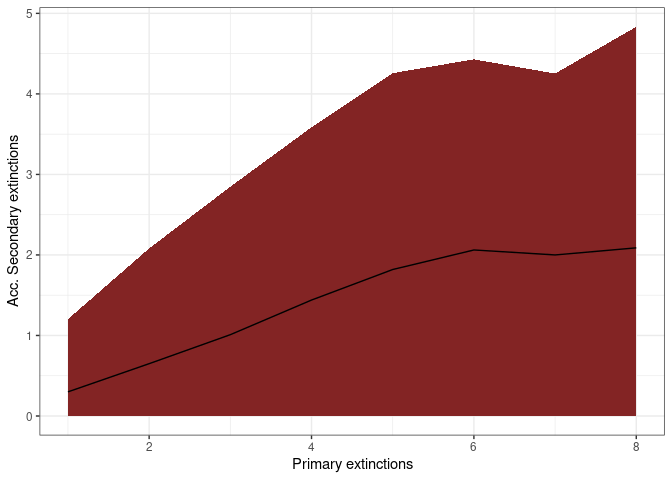
Figure 5. The resulting graph of the RandomExtinctions function
The RandomExtinctons() function generates a null
hypothesis for us to compare it with either an extinction history
generated by the ExtinctionOrder() function or the
Mostconnected() function. In order to compare the expected
extinctions developed by our null hypothesis with the observed
extinction history, we developed the CompareExtinctions()
function. The way to use this last function is to first create the
extinction history and the null hypothesis, and then the
CompareExtinctions() function to compare both extinction
histories.
data("net")
Comparison <- CompareExtinctions(Nullmodel = Test, Hypothesis = Order)The result will be a graph (Figue 6) with a dashed line showing the observed extinction history and a solid line showing the expected value of secondary extinctions randomly generated.
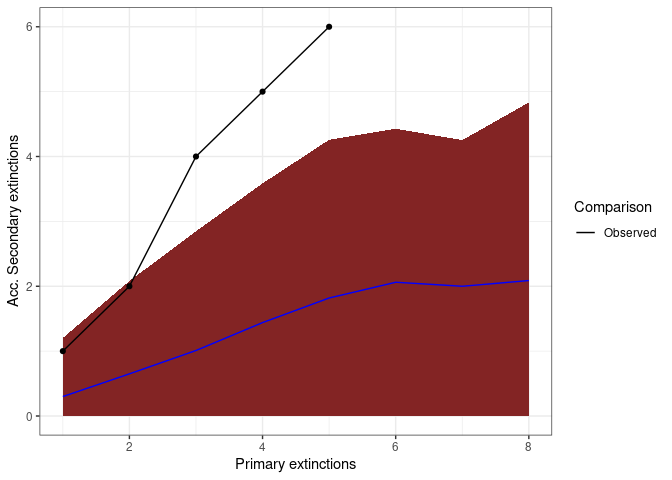
Figure 6. The resulting graph of the CompareExtinctions function, where the dashed line shows the observed extinction history, and a solid line shows the expected value of secondary extinctions originated at random
The ExtinctionPlot() function takes a NetworkTopology
class object and plots the index of interest after every extinction. By
default, the function plots the number of accumulated secondary
extinctions after every primary extinction (Figure 7), but any of the
indexes can be plotted with the function by changing the Variable
argument (Figure 8).
data(net)
ExtinctionPlot(History = Order[[1]])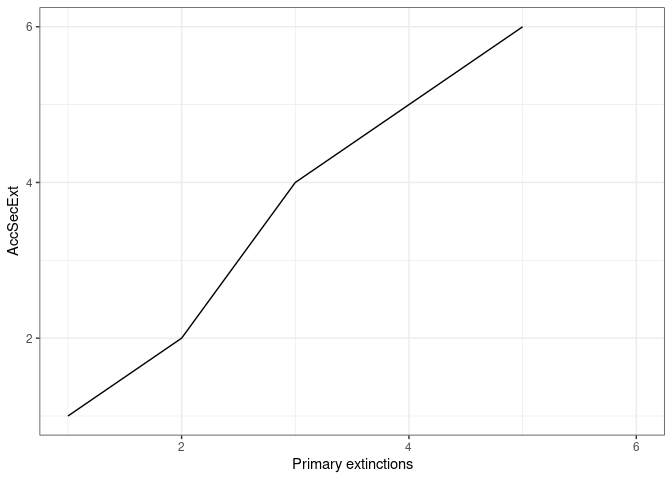
Figure 7. Example of the use of the ExtinctionPlot function showing the accumulated secondary extinctions against number of extinctions
ExtinctionPlot(History = Order[[1]], Variable = "Link_density")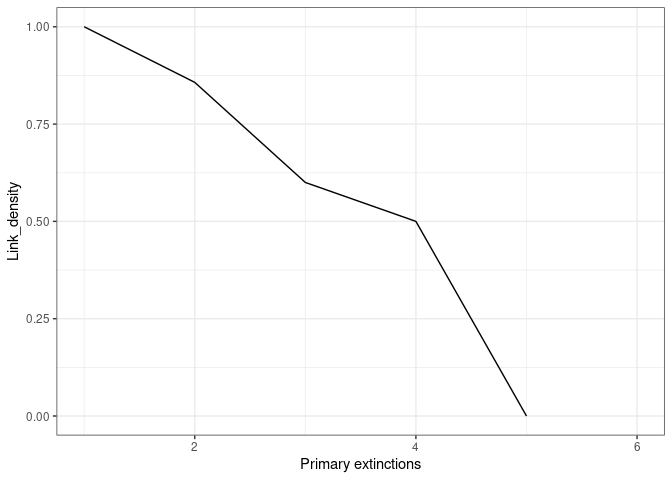
Figure 8. Another example of the use of the ExtinctionPlot function showing the number of links per species against number of extinctions
The DegreeDistribution() function calculates the
cumulative distribution of the number of links that each species in the
food network has (Estrada 2007). Then, the observed distribution is
fitted to the exponential, and power law models.
The results of this function are shown in figure 9 and table 4. The graph shows the observed degree distribution in a log log scale fitting the three models mentioned above, for this example we use an example dataset of Chilean litoral rocky shores (Kéfi et al. 2015). The table shows the fitted model information ordered by descending AIC, that is, the model in the first row is the most probable distribution, followed by the second an finally the third distribution in this case (Table 3), the Exponential distribution would be the best model, followed by the Power law model.
data("chilean_intertidal")
DegreeDistribution(chilean_intertidal)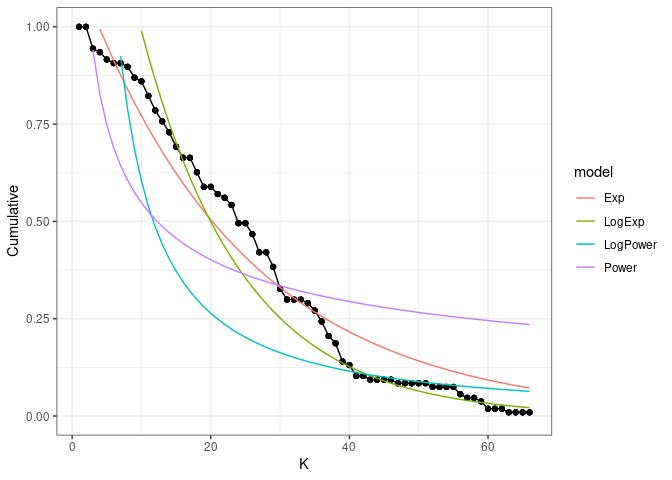
Figure 9: Fitted vs observed values of the degree distribution. The black line and points show the observed values, the red, green and blue lines show the fitted values for the Exponential, power law and trucated distribution, respectively
| logLik | AIC | BIC | model | Normal.Resid | family |
|---|---|---|---|---|---|
| 83.14753 | -160.29506 | -153.63654 | Exp | No | Exponential |
| 13.38647 | -20.77293 | -14.20397 | Power | No | PowerLaw |
| -27.48222 | 60.96444 | 67.53341 | LogExp | No | Exponential |
| -80.84172 | 167.68343 | 174.25240 | LogPower | No | PowerLaw |
Table 4: Model selection analysis
The main objective of fitting the cumulative distribution of the degrees to those models, is to determine if the vulnerability of the network to the removal of the most connected species is related to their degree distribution. Networks that follow a power law distribution are very vulnerable to the removal of the most connected nodes, while networks that follow exponential degree distribution are less vulnerable to the removal of the most connected nodes (Albert and Barabási 2002; Dunne, Williams, and Martinez 2002; Estrada 2007; Santana et al. 2013).
By default, the functions in NetworkExtinction assume that,
for a secondary extinction to happen, a node needs to loose all
connections to its prey (if NetworkType == "Trophic") or
all other nodes (if NetworkType == "Mutualistic").
One may also want to assume that species are only capable of
sustaining existence given a threshold of remaining interaction
strengths. This is implemented with the IS argument, with
which one can either set a global node-dependency on interaction
strengths or, alternatively, define an IS value for each
node in the supplied network.
As a minimal example, let’s consider primary extinctions of two of the producers in our toy network not taking into account any interaction strength loss thresholds:
IS_0 <- SimulateExtinctions(Network = net, Order = 1:2, Method = "Ordered")[[1]]| Spp | S | L | C | Link_density | Modularity | SecExt | Pred_release | Iso_nodes | AccSecExt | NumExt | TotalExt |
|---|---|---|---|---|---|---|---|---|---|---|---|
| 1 | 9 | 9 | 0.1111111 | 1.0000000 | 0.2901235 | 1 | 0 | 0 | 1 | 1 | 2 |
| 2 | 7 | 6 | 0.1224490 | 0.8571429 | 0.0000000 | 1 | 0 | 0 | 2 | 2 | 4 |
Table 5: The resulting dataframe of the basic version of SimulateExtinctions
As you can see, with the base version of
SimulateExtinctions(), we obtain two secondary
extinctions.
Now, let’s consider that all our species in net need to
retain a minimum of 70% of interaction strength to not go extinct
(rather than a 0% as is the default):
IS_0.7 <- SimulateExtinctions(Network = net, Order = 1:2, Method = "Ordered", IS = 0.7)[[1]]| Spp | S | L | C | Link_density | Modularity | SecExt | Pred_release | Iso_nodes | AccSecExt | NumExt | TotalExt |
|---|---|---|---|---|---|---|---|---|---|---|---|
| 1 | 9 | 9 | 0.1111111 | 1.0000000 | 0.2901235 | 1 | 1 | 0 | 1 | 1 | 2 |
| 2 | 7 | 6 | 0.1224490 | 0.8571429 | 0.0000000 | 3 | 2 | 0 | 4 | 2 | 6 |
Table 6: The resulting dataframe of the interaction-strength loss version of SimulateExtinctions
As you can see, this drastically changes how many secondary extinctions we estimate.
Ecological networks aren’t static and we should assume that species
may shift their connections in response to extinctions of an
association/interaction partner. Rewiring processes can be simulated
with NetworkExtinction using the Rewiring,
RewiringDist, and RewiringProb arguments.
Let’s start with RewiringDist. This should be a matrix
that contains information about similarities or rewiring potential of
species indexed by columns to those indexed by rows. The package comes
with an example data set for this:
data(dist)
dist
#> 1 2 3 4 5 6 7
#> 1 0.00000000 0.4593111 0.10593644 0.30189790 0.4705959 0.1783138 0.4530299
#> 2 0.45931109 0.0000000 0.56524753 0.76120899 0.8902942 0.5980121 0.8727282
#> 3 0.10593644 0.5652475 0.00000000 0.19596146 0.5765323 0.2842503 0.5589664
#> 4 0.30189790 0.7612090 0.19596146 0.00000000 0.7724938 0.4802117 0.7549278
#> 5 0.47059588 0.8902942 0.57653232 0.77249378 0.0000000 0.2922820 0.5669981
#> 6 0.17831383 0.5980121 0.28425027 0.48021173 0.2922820 0.0000000 0.2747161
#> 7 0.45302992 0.8727282 0.55896636 0.75492782 0.5669981 0.2747161 0.0000000
#> 8 0.20346538 0.6627765 0.09752893 0.09843253 0.6740613 0.3817792 0.6564953
#> 9 0.01647744 0.4428337 0.12241388 0.31837534 0.4870733 0.1947913 0.4695074
#> 10 0.54697008 0.4174089 0.44103364 0.63699510 0.5059987 0.7252839 1.0000000
#> 8 9 10
#> 1 0.20346538 0.01647744 0.5469701
#> 2 0.66277647 0.44283365 0.4174089
#> 3 0.09752893 0.12241388 0.4410336
#> 4 0.09843253 0.31837534 0.6369951
#> 5 0.67406125 0.48707331 0.5059987
#> 6 0.38177920 0.19479127 0.7252839
#> 7 0.65649529 0.46950735 1.0000000
#> 8 0.00000000 0.21994281 0.5385626
#> 9 0.21994281 0.00000000 0.5634475
#> 10 0.53856257 0.56344752 0.0000000This is a random distance matrix. For the sake of this example, we assume that these values represent probabilities of rewiring. We have to tweak it a bit to make it useful for our toy example of a trophic network, we do so by setting some of the values to 0:
dist[,1:4] <- 0 # producers don't worry about rewiring
dist[5:10,5:8] <- 0 # intermediate consumders can only rewire to producers
dist[c(1:4, 9:10), 9:10] <- 0 # apex predators can only rewire to intermediate consumers
dist
#> 1 2 3 4 5 6 7 8 9 10
#> 1 0 0 0 0 0.4705959 0.1783138 0.4530299 0.20346538 0.0000000 0.0000000
#> 2 0 0 0 0 0.8902942 0.5980121 0.8727282 0.66277647 0.0000000 0.0000000
#> 3 0 0 0 0 0.5765323 0.2842503 0.5589664 0.09752893 0.0000000 0.0000000
#> 4 0 0 0 0 0.7724938 0.4802117 0.7549278 0.09843253 0.0000000 0.0000000
#> 5 0 0 0 0 0.0000000 0.0000000 0.0000000 0.00000000 0.4870733 0.5059987
#> 6 0 0 0 0 0.0000000 0.0000000 0.0000000 0.00000000 0.1947913 0.7252839
#> 7 0 0 0 0 0.0000000 0.0000000 0.0000000 0.00000000 0.4695074 1.0000000
#> 8 0 0 0 0 0.0000000 0.0000000 0.0000000 0.00000000 0.2199428 0.5385626
#> 9 0 0 0 0 0.0000000 0.0000000 0.0000000 0.00000000 0.0000000 0.0000000
#> 10 0 0 0 0 0.0000000 0.0000000 0.0000000 0.00000000 0.0000000 0.0000000This matrix makes a lot more sense for our purposes. To clarify once more how to read this data: species 8 (column) has a \(.663\) chance of rewiring to species 2 (row).
Next, Rewiring is a function argument that, just like
the IS argument can be set globally or individually for
each node. It is used to calculate probabilities of rewiring from the
data in RewiringDist. Since we assume
RewiringDist to already contain probabilities in this
example, we simply set RewiringDist to return the data
without changing it:
RewiringDist <- function(x){x}Lastly, RewiringProb is called upon to determine whether
rewiring can happen among all potential rewiring partners. If no
potential rewiring partner comes with a probability higher than this
threshold, no rewiring happens. If multiple potential partners meet this
threshold, rewiring happens only to the potential partner with the
highest probability. Let’s keep the default of 50% here.
Finally, let’s out this all together with the IS example
from above. Can we reduce the number of secondary extinctions when
allowing for rewiring?
Rewiring <- SimulateExtinctions(Network = net, Order = 1:2, Method = "Ordered", IS = 0.7,
Rewiring = function(x){x}, RewiringDist = dist, RewiringProb = 0.5)[[1]]| Spp | S | L | C | Link_density | Modularity | SecExt | Pred_release | Iso_nodes | AccSecExt | NumExt | TotalExt |
|---|---|---|---|---|---|---|---|---|---|---|---|
| 1 | 9 | 9 | 0.1111111 | 1.000 | 0.2901235 | 0 | 0 | 0 | 0 | 1 | 1 |
| 2 | 8 | 7 | 0.1250000 | 0.875 | 0.3571429 | 1 | 1 | 0 | 1 | 2 | 3 |
Table 7: The resulting dataframe of the rewiring version of SimulateExtinctions
Indeed, this made it so we have one less secondary extinction at the second primary extinction!